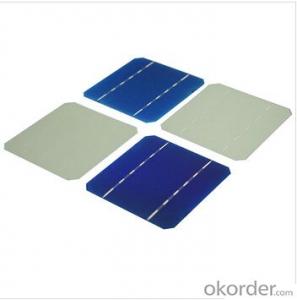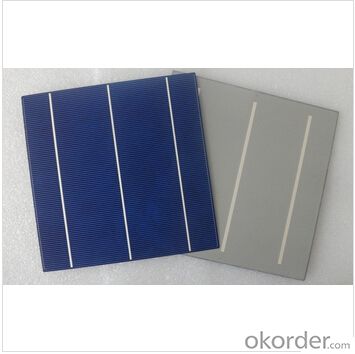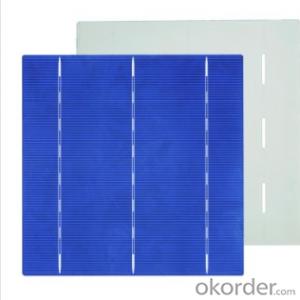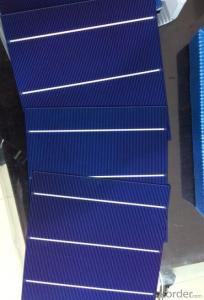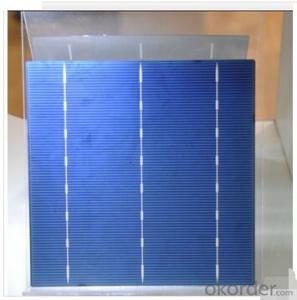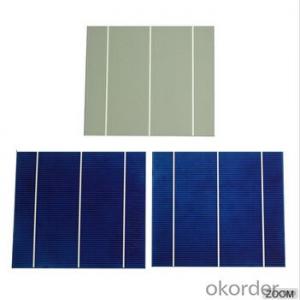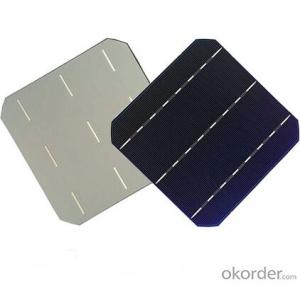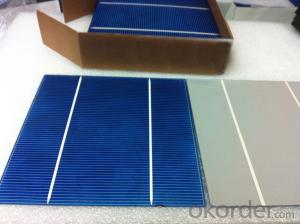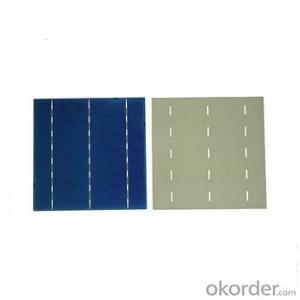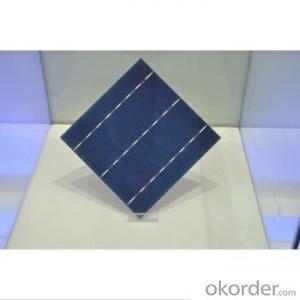Dye Based Polycrystalline Solar Cell High Quality 18.60%-18.80% Effy
- Loading Port:
- Shanghai
- Payment Terms:
- TT OR LC
- Min Order Qty:
- 1000 pc
- Supply Capability:
- 1000000 pc/month
OKorder Service Pledge
OKorder Financial Service
You Might Also Like
Solar Cells:
solar cells, when struck by photons of light from the sun, generates an electrical current which can then be used to power DC or AC electrical loads.
A solar cell is made of silicon. Computer chips are made of this same material. Basically, when light strikes the surface of a solar cell some of it is absorbed into the silicon. This light energy bumps the electrons loose and causes energy to flow
Solar cells is made by solar wafer, it has three categories of solar cell right now, monocrystalline polycrystalline and thin film,These cells are entirely based around the concept of PN junction, which is the critical part of solar module, it is the part that can convert the light energy into electricity, the thickness is from 180um to 200um, with even busbars to conduct electricity, textured cell can decrease diffuse reflection; they are often electrically connected and encapsulated as a module. Photovoltaic modules often have a sheet of glass on the front (sun up) side, allowing light to pass while protecting semiconductor wafers from abrasion and impact due to wind-driven debris, rain, hail, etc. Solar cells are also usually connected in series in modules, creating an additive voltage. Connecting cells in parallel will yield a higher current;With high quality and stable quality. Our Cells can greatly improve the performance of Solar Modules.
Features:
High efficiencies up to 16.4%
Proven long term mechanical stability of silicone
Make of highly purified poly silicone
Three bus bars for reduced series resistance and improved module and cell efficiency
Blue anti-reflecting coating ensures improved light absorption and increased efficiency
Acid texturization offers a uniform appearance and virtually invisible crystal structure
Excellent low light behavior for improved energy yield
Specifications
Efficiency(%) | Pmpp(W) | Umpp(V) | Impp(A) | Uoc(V) | Isc(A) | FF(%) |
18.60-18.80 | 4.53 | 0.54 | 8.382 | 0.637 | 9.084 | 78.23 |
18.40-18.60 | 4.48 | 0.536 | 8.354 | 0.636 | 9.062 | 77.7 |
18.20-18.40 | 4.43 | 0.533 | 8.31 | 0.635 | 9.033 | 77.22 |
18.00-18.20 | 4.38 | 0.532 | 8.234 | 0.634 | 8.987 | 76.88 |
17.80-18.00 | 4.33 | 0.529 | 8.189 | 0.633 | 8.951 | 76.45 |
17.60-17.80 | 4.29 | 0.527 | 8.128 | 0.632 | 8.922 | 75.96 |
17.40-17.60 | 4.24 | 0.525 | 8.066 | 0.629 | 8.902 | 75.63 |
Solar Cells Advantage:
• High efficiency and stable performance in photovoltaic conversion.
• Advanced diffusion technique ensuring the homogeneity of energy conversion efficiency of the cell.
• Advanced PECVD film forming, providing a dark blue silicon nitride anti-reflection film of homogenous color and attractive appearance.
• High quality metal paste for back surface and electrode, ensuring good conductivity, high pulling strength and ease of soldering.
• High precision patterning using screen printing, ensuring accurate busbar location for ease with automatic soldering a laser cutting.
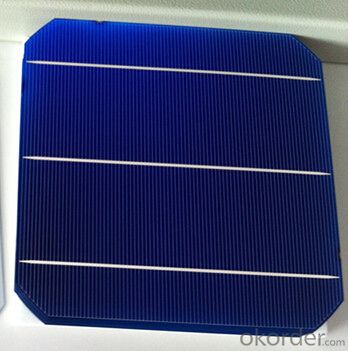
FAQ
We have organized several common questions for our clients,may help you sincerely:
①What price for each watt?
It depends on the efficiency of the solar cell, quantity, delivery date and payment terms.
②How long can we receive the product after purchase?
In the purchase of product within three working days, We will arrange the factory delivery as soon as possible. The pecific time of receiving is related to the state and position of customers.Commonly 7 to 10 working days can be served.
③Can you provide the peripheral products of the solar panels, such as the battery, controller, and inverter? If so, can you tell me how do they match each other?
Yes, we can, we have two companies for solar region, one is CNBM International, the other is CNBM engineering Co.
We can provide you not only the solar module but also the off grid solar system, we can also provide you service with on grid plant.
④What is your warranty of solar cell?
Our product can promise lower than 0.3% open box crack, we support claim after opening the box if it has crackm color difference or sth, the buyer should give pictures immediately, we can not accept the claim after the solar cell has assembled to solar panel.
• Timeliness of delivery
• ⑤How do you pack your products?
We have rich experience on how to pack the solar cell to make sure the safety on shipment, we could use wooden box or pallet as buyer's preference.
- Q: What is the impact of solar cells on reducing energy waste?
- Solar cells have a significant impact on reducing energy waste by harnessing the sun's energy and converting it into electricity. By utilizing renewable and clean energy sources, solar cells contribute to reducing the dependence on fossil fuels, which are finite and contribute to environmental pollution. Additionally, solar cells help decrease energy waste by generating electricity at the point of use, minimizing transmission and distribution losses.
- Q: Can solar cells be used in mobile devices?
- Yes, solar cells can be used in mobile devices. In fact, many manufacturers are now incorporating solar panels into smartphones, tablets, and other portable gadgets to harness solar energy and provide an alternative source of power.
- Q: How do solar cells handle electromagnetic pulses?
- Solar cells are generally not designed to handle electromagnetic pulses (EMPs) as they are highly sensitive electronic devices. Strong EMPs, such as those caused by a nuclear explosion or a solar storm, can potentially damage or destroy solar cells by overwhelming their circuitry. However, it is worth noting that the likelihood of solar cells being directly affected by EMPs is relatively low, as they are often shielded by other components of the solar panel system such as inverters and wiring.
- Q: Are there any health risks associated with solar cells?
- There are no direct health risks associated with solar cells themselves. However, the manufacturing process of solar cells involves the use of certain chemicals and materials that can be harmful if not handled properly. Additionally, improper installation or maintenance of solar panels can pose electrical and fire hazards. Thus, it is important to ensure proper safety measures are followed during production, installation, and maintenance to minimize any potential health risks.
- Q: Can solar cells be used for powering submarines?
- Yes, solar cells can be used for powering submarines to some extent. However, due to limitations in surface area and the amount of sunlight that can penetrate the water, solar power alone is not sufficient to power submarines for long durations or at great depths. Submarines typically rely on a combination of diesel-electric engines and rechargeable batteries for propulsion and power generation.
- Q: Are solar cells affected by electromagnetic radiation?
- Yes, solar cells are affected by electromagnetic radiation. In fact, solar cells rely on electromagnetic radiation, specifically sunlight, to generate electricity.
- Q: Can solar cells be used for powering remote data collection devices?
- Yes, solar cells can be used for powering remote data collection devices. Solar cells harness sunlight and convert it into electricity, providing a reliable and sustainable source of power for devices located in remote areas where access to traditional power sources may be limited or unavailable.
- Q: Can solar cells be used in off-grid water desalination?
- Yes, solar cells can be used in off-grid water desalination. Solar energy can be harnessed to power the desalination process, providing a sustainable and renewable energy source for converting seawater into fresh water in off-grid locations. This allows for the production of clean drinking water without the need for a traditional electricity grid.
- Q: Can solar cells be used in large-scale power plants?
- Yes, solar cells can be used in large-scale power plants. Large solar power plants, also known as solar farms or solar parks, employ thousands or even millions of solar panels or solar modules to convert sunlight into electricity. These power plants are capable of generating significant amounts of renewable energy, contributing to the overall energy grid and reducing dependence on fossil fuels.
- Q: Can solar cells be used in off-grid cabins or cottages?
- Yes, solar cells can definitely be used in off-grid cabins or cottages. Solar panels can generate electricity by converting sunlight into usable energy, which can then be stored in batteries for later use. This makes them an excellent choice for powering remote locations like off-grid cabins or cottages where access to the electrical grid may be limited or non-existent.
Send your message to us
Dye Based Polycrystalline Solar Cell High Quality 18.60%-18.80% Effy
- Loading Port:
- Shanghai
- Payment Terms:
- TT OR LC
- Min Order Qty:
- 1000 pc
- Supply Capability:
- 1000000 pc/month
OKorder Service Pledge
OKorder Financial Service
Similar products
Hot products
Hot Searches
Related keywords
